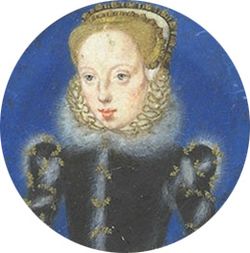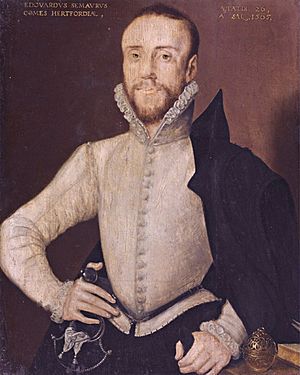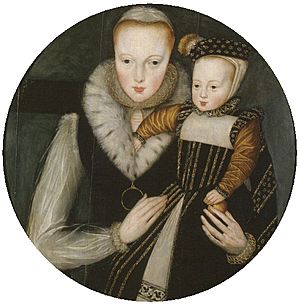Lady Katherine Grey facts for kids
Quick facts for kids Lady Katherine Grey |
|
|---|---|
| Lady Herbert Countess of Hertford |
|

Miniature by Levina Teerlinc, c. 1560
|
|
| Born | 25 August 1540 Bradgate Park, near Leicester |
| Died | 26 January 1568 (aged 27) Cockfield Hall, Yoxford, Suffolk |
| Burial | Salisbury Cathedral |
| Spouse |
|
| Issue | Edward Seymour, Lord Beauchamp Thomas Seymour |
| House | Grey |
| Father | Henry Grey, 1st Duke of Suffolk |
| Mother | Lady Frances Brandon |
Katherine Seymour, Countess of Hertford (born Lady Katherine Grey) was an important figure in English history. She was born on August 25, 1540. Katherine was the younger sister of Lady Jane Grey, who was briefly Queen of England.
Katherine was also a granddaughter of Henry VIII's sister, Mary Tudor, Queen of France. This made her a potential heir to the English throne. However, her secret marriage to Edward Seymour, 1st Earl of Hertford angered Elizabeth I. Katherine spent the rest of her life in captivity. She had two sons while imprisoned in the Tower of London. She died at the age of 27.
Contents
Katherine's Family and Claim to the Throne
Lady Katherine was born on August 25, 1540. Her birthplace was Bradgate Park, near Leicester. She was the second daughter of Henry Grey, 1st Duke of Suffolk. Her mother was Lady Frances Brandon. Katherine had an older sister, Lady Jane Grey, and a younger sister, Lady Mary Grey.
Katherine's grandmother was Mary Tudor, Queen of France. Mary Tudor was the youngest daughter of Henry VII of England. This family connection gave Katherine a strong claim to the English throne. She was in line to become queen after Henry VIII's own children. These were Prince Edward, Lady Mary, and Lady Elizabeth. Henry VIII's will also placed the Grey sisters next in line. This was because he had excluded the Scottish royal family from the English succession.
Katherine's First Marriage
Before August 1552, Katherine Grey was promised in marriage. Her future husband was Henry, Lord Herbert. In 1553, King Edward VI was very ill. The King and his chief minister, John Dudley, 1st Duke of Northumberland, made a plan. They wanted to prevent Edward's sister Mary Tudor from becoming queen. Instead, they planned for Katherine's older sister, Lady Jane Grey, to take the throne.
According to a special document from June 21, 1553, Lady Katherine was to be second in line. She would be after her sister Jane and any male heirs. Lady Jane had married Northumberland's son, Lord Guildford Dudley, on May 25, 1553. On the same day, Lady Katherine married Lord Herbert. Their wedding took place at Durham House. After the wedding, Katherine, now Lady Herbert, lived with her husband. They lived at Baynard's Castle by the River Thames.
However, Lady Jane's time as queen did not last. Henry's father wanted to distance himself from the Grey family. He arranged for his son to separate from Lady Katherine. Their marriage was likely cancelled in early 1554. Meanwhile, Katherine's sister, Lady Jane Grey, and her father, the Duke of Suffolk, were executed. This happened in February 1554, after a rebellion was stopped.
A Potential Royal Heir
During the early reign of Queen Mary I, Lady Katherine was a senior heir to the throne. This was because Mary was not yet married. Her younger sister Elizabeth was also considered illegitimate by some. Katherine's claim became important again when Elizabeth I became queen in November 1558.
At one point, Queen Elizabeth seemed to consider Lady Katherine Grey as a possible Protestant heir. There were even rumors that Elizabeth might adopt her. However, these plans ended when Lady Katherine secretly married Lord Hertford.
Katherine's Secret Second Marriage
One of Lady Katherine's friends was Lady Jane Seymour. Lady Jane introduced her brother, Edward Seymour, 1st Earl of Hertford, to Lady Katherine Grey. Katherine was called "Lady Katherine Grey" again after her first marriage was cancelled.
Without the Queen's permission, Katherine and Edward married. Their secret ceremony took place in December 1560. It happened at Lord Hertford's house in Cannon Row. Lady Jane Seymour was the only witness. Soon after, the Queen sent Lord Hertford on a trip across Europe. This trip was for his education. Lord Hertford gave his wife a document. This document would prove their marriage if he died. However, Katherine lost the document. When Lady Jane Seymour died in 1561, Katherine could not prove her marriage.
Life in Imprisonment
Katherine kept her marriage a secret for many months. She even kept it secret after she became pregnant. When she was eight months pregnant, she was traveling with the royal court. She decided to ask someone to speak to the Queen for her. She first told Bess of Hardwick, who refused to help. Bess was angry that Katherine had involved her.
Katherine then went to Robert Dudley, 1st Earl of Leicester. He was her late sister's brother-in-law. She visited his room in the middle of the night. She explained her difficult situation. Dudley's room was next to the Queen's. He was afraid they might be heard. He also worried about being caught with a pregnant woman. He tried to get Katherine to leave quickly. The next day, he told Queen Elizabeth everything.
Queen Elizabeth was furious. Her cousin had married without her knowledge or permission. This marriage also affected plans with Scotland. A possible marriage between Katherine and the Earl of Arran was now impossible. He was a young nobleman with a strong claim to the Scottish throne. The Queen also did not approve of Katherine's choice of husband. Elizabeth was still unmarried herself. She feared that Katherine having sons could lead to a rebellion. People might support Katherine as queen. At this time, a book by John Hales argued for Katherine's claim to the throne.
Queen Elizabeth sent Lady Katherine to the Tower of London. Edward Seymour was sent to join her there when he returned to England. Bess of Hardwick was also imprisoned. Elizabeth believed the marriage was part of a larger plot against the Crown. Sir Edward Warner, the Lieutenant of The Tower, allowed Katherine and Edward to visit each other secretly. Warner reported that Katherine's room was damaged. Her pet monkey and dogs had caused the damage. While imprisoned, Katherine gave birth to two sons:
- Edward Seymour (1561–1612)
- Thomas Seymour (1562/3 – August 8, 1600). He was baptized on February 11, 1563. Thomas married Isabel Onley. They did not have any children.
In 1562, the marriage was officially cancelled. This meant that their children were not recognized as legal heirs to the throne. However, people still considered them as potential heirs to the Crown.
Katherine's Final Years
After her second child was born in 1563, the Queen was very angry. She ordered Katherine to be separated permanently from her husband and older son. Katherine was moved to the care of her uncle, Sir John Grey, at Pirgo. She stayed there until November 1564. Then, she was moved to the care of Sir William Petre. She was with him for two years, likely at Ingatestone Hall.
After that, she was moved to Sir John Wentworth's care at Gosfield Hall. After seventeen months there, she was taken to Cockfield Hall in Yoxford, Suffolk. Lady Katherine died fourteen days later, on January 26, 1568. She was only twenty-seven years old. She died from consumption. She was first buried at the Cockfield Chapel in Yoxford Church. Later, her body was moved to Salisbury Cathedral. She was buried next to her husband there.
Family Tree
This chart shows Lady Katherine Grey's connection to the House of Tudor. It also shows other people who claimed the English throne. Italics mean people who died before Edward VI. Arabic numbers show the line of succession to Edward VI based on Henry VIII's will. Roman numerals show the line of succession based on Edward's will.
| Henry VII | Elizabeth of York | ||||||||||||||||||||||||||||||||||||||||||||||||||||||||||||||||
| Henry VIII | Margaret Tudor | Mary Tudor | Charles Brandon | ||||||||||||||||||||||||||||||||||||||||||||||||||||||||||||||
| Edward VI | Mary I (1) |
Elizabeth I (2) |
James V of Scotland | Margaret Douglas | Frances Brandon | Henry Grey | |||||||||||||||||||||||||||||||||||||||||||||||||||||||||||
| Mary, Queen of Scots | Henry Stuart | Jane Grey (3, I) |
Katherine Grey (4, II) |
Mary Grey (5, III) |
|||||||||||||||||||||||||||||||||||||||||||||||||||||||||||||
See also
 In Spanish: Catalina Grey para niños
In Spanish: Catalina Grey para niños



